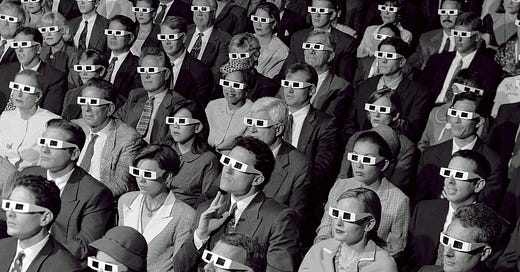Are these shoes bad?
Slack and Cole Haan have teamed up for the collaboration we never knew we needed. This week, we explore what this partnership says about us.
Tech companies and reality - separation anxiety
From weirdo huckster founders and infantilizing workspaces, to burnout-inducing cultures, tech companies can be divorced from reality in depressing ways. Nevertheless, they continue to be some of the most sought after employment destinations.
💻💻 For more like this, once a week, subscribe below:
Founders, workspaces, and cultures--those are internal aspects of tech companies’ separation from reality, brought on by those working for them. From the outside, consumers help widen this divide by unduly fawning over their announcements and products. This fawning mutates the traditional producer/consumer relationship into something bleak.
This week, millions of people watched Apple debut four new versions of its iPhone 12, as well as a new HomePod mini (a voice-controlled speaker). Spending an hour and ten minutes watching what amounts to a prolonged advertisement for full-priced products requires levels of masochism usually exhibited in only the most practiced of bootlickers.
Unfortunately, this masochism is misconstrued as ‘being a fan of Apple’. Being a fan of a product versus just liking it is an important distinction: the former implies you’re enthusiastically devoted, the latter that you enjoy it for its intended purpose.

This deranged prostrating at the altar of tech companies isn’t confined to Apple - Sony, Facebook, Microsoft, and Google, all have their own events for consumers to gape at their newest products. For more aggregated forms of worship, the year round roster of industry events like South by Southwest (SXSW) and Consumer Electronics Show (CES) showcase several brands at once.
The fandom surrounding tech companies elevates them from beyond consumer products and into the realm of the arts--stuff that would ordinarily evoke enthusiastic devotion. Expressions of devotion to brands are purchases, anything more is sad.
Speaking their truth
In many cases, tech companies’ mission statements put their separation from reality into words. Take streaming audio service Spotify’s:
“Our mission is to unlock the potential of human creativity.”
Spotify is a software that allows you to play songs and podcasts. It also generates algorithms to suggest new things to listen to based off of your past listens. It’s a great product, but it’s by no means a code-based muse that unlocks our dormant kernels of creativity on the way to composing our magnum opuses. It helps perpetuate the ‘unlocking’ of this same human creativity by paying the artists whose songs it streams an average of $0.00437 per listen.
Slack, a corporate version of AOL instant messenger that distinguishes itself from its extinct relative by its ability to live on your smartphone as well as enabling you to search and infinitely store chat history, has a similarly off-putting mission statement:
“Make work life simpler, more pleasant and more productive.”
This stuff sucks
The average slack user sends and receives between 800 and 2,500 messages a month, and most users respond to a message in slightly less than 12 minutes. These written messages arrive in addition to email, of which the average office worker receives 121 daily.
Rather than replacing email, Slack has at best bifurcated written communication so that you now receive it in two places, rather than one. At worst, it’s increased the volume of messaging you receive in a given day. Not only that, but since Slack lives on your phone as well as your computer, you now have two venues to hear from colleagues at unwelcome times.
Given the above, and that it takes roughly 23 minutes to return to a task after being interrupted, it seems ‘a simpler, more pleasant, and more productive’ work life would be one absent of Slack.
A Pointed Pointless Partnership
Turning its trial-separation from reality into a permanent divorce, Slack last week released their own branded shoes in conjunction with Cole Haan.

Pictured: the shoes
As part of the collaboration, the shoes carry the Slack logo and are colored with Slack’s neon-pastel colorways. More importantly, the partnership proves two important points:
People at Slack thought their company had strong enough brand equity in the wider world to merit a co-branded sneaker (internal separation from reality).
And, that a demand for corporation-branded sneakers exists. Companies like Slack and Cole Haan don’t do anything without diligence, which means some data-point somewhere said people would use money to buy these shoes (external separation from reality).
It’s the meta product-about-a-product nature of these shoes that make them so depressing. It’s akin to buying a broom with a Nike Swoosh on it.
That there’s a market for the shoes is yet another sign that Americans have an unhealthy relationship with work. Despite being one of the most productive countries on Earth, US workers spend more hours working per year than any other large nation. Each pair sold is a bleak reminder of tech’s unhinged reality and our sad relationship to work.
💻💻 If you liked it, share with your friends!
👍👍 Had a taste and want more (once a week)?
Song of the week: In honor of two troubling themes converging, Natalie Imbruglia’s “Troubled by the way we came together.”





I'm late to the party, sorry! :D
So... does this mean no more Coke worshipping? :o
(I don't drink Coke BTW haha, but I know so many Americans treat it almost like it's divine)
As for Slack, which I use to communicate with my publisher, I found a simple solution. I *never* look at it until I'm done with my current writing session. Since my sessions are typically 25 to 60 minutes long, it works out well enough.
Not just Slack, for that matter. I apply the same rule to any possible 'distraction'--emails, forums, social media platforms... Substack and Discord too ;)
Good article Jared. I had a similar thought when apple had their introduction “show” last week. It has become a media, entertainment event. Customers hang on every word because they must have it.